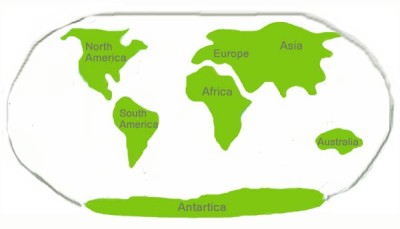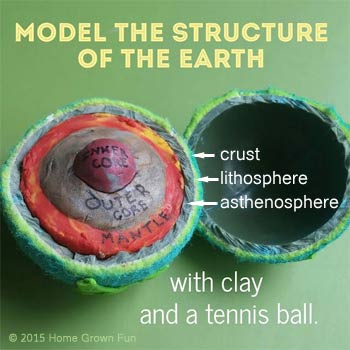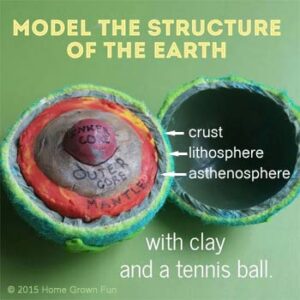The core, mantle and crust make up the layers of the earth.
Learn about the earth’s layers and plate tectonics by making your own scale model using a tennis ball and clay.
Materials Needed:
- Tennis ball (an old one that does not bounce well works great). This is your planet earth!
- Utility knife (for an adult to use)
- Small, inexpensive blocks of polymer clay: green, red, yellow and gray (metallic colored clay can replace the gray if you want to get fancy. If it is cost effective to buy a set of clay in different colors, do it. Don’t spend extra money to get the perfect colors. The clay will be used to make the layers of the earth.
- Blue acrylic paint to represent the oceans (only need enough to cover the outside of the tennis ball)
- Permanent marker to label the layers
- Glue gun (optional – see last step)
Create this quick and easy earth model. It’s geographic! It’s educational! It’s fun!
- CUT THE TENNIS BALL IN HALF: Have an adult CUT THE TENNIS BALL in half using a sharp blade such as a utility knife. Adults, go slow and keep your fingers away from the blade.
- PAINT the outside of the tennis ball blue to represent water. Let dry. While the paint dries, review the next steps and study the image.
- MAKE THE MANTLE: Start with half of the hollow tennis ball. Mix equal parts of red and yellow clay by working it with your hands. Total amount of clay would be about the size of a ping pong ball. Press it into the cross section of the tennis ball using your thumbs. The layer should be about 1/4″ thick. Don’t measure the thickness, just have fun! This layer is the MANTLE. It consists of both hard and soft, hot rock. See the image and read more about the mantle below.
- MAKE THE OUTER CORE: Next choose the gray clay to create the next layer, called the OUTER CORE. Add a small amount of red clay to the gray and knead to create faint swirls. It’s fun to mix colors of clay, especially if the colors are left to create designs. The outer core is extremely hot. Create a depression (hole) in the middle of this layer for the INNER CORE.
- To make the INNER CORE, roll red clay into a ball. Add tiny bits of gray clay for texture. Roll it smooth between your hands. Fit it into the inner most hole. The tennis ball should be filled with different layers of clay.
- LABEL THE LAYERS: Write the names of the layers on the clay with permanent marker, keeping a light touch with the marker. If the ink is not adhering to the clay, wait until the clay dries more.
- IDENTIFY THE CRUST: Look at your tennis ball and notice that the rough skin is a perfect representation of the earth’s crust. Learn more using the guide below and become familiar with the lithosphere and asthenosphere (shown in the image) if you’re ready.
- LEARN ABOUT PLATES: Wow! Your earth model is almost done. When the earth cooled from a liquid state a long, long time ago, the crust and upper mantle broke into 12 segments or PLATES. These plates float on the mantle which is dense and flexible. We live on land and there are seven continents of land on earth that exist above plates. The lithosphere shown in the image is the home of the plates. The plates continuously move and are often referred to as tectonic plates. Tectonic means having a large impact.

- CREATE CONTINENTS: To make the continents, refer to the map here showing green continents. Use your green clay to make shapes that resemble the continents. They do not need to be perfect. Blobs work just as well. The clay continents will hold up better if they have rounded edges. Europe and Asia are connected so make those two continents using one piece of clay. Press the green continents on top of the tennis ball and discuss that they move on top of plates. We don’t notice them moving but over a long period of time, they moved long distances. In fact, all the continents were once one piece called Pangea!
- OPTIONAL: To attach the continents use a hot glue gun (adult) and carefully glue the clay pieces to the ball.
Kids! Close the earth up and open it to surprise your family and friends. Explain how the layers work.
We recommend you don’t share your new model with the dog!
Store your model in an airtight plastic bag if you want to reuse the clay later.
The earth consists of four layers: inner core, outer core, mantle and crust.
INNER CORE
- The core is about half the diameter of the earth. The core is dense and scientists suspect that a gallon of it would weigh at least 100 pounds!
- The INNER CORE is very hot and probably made of solid iron and nickel but we can’t know for sure its exact makeup.
OUTER CORE
- The outer core is liquid and surrounds the inner core. It is most likely made of iron and nickel too and is also extremely hot.
MANTLE
- The mantle surrounds the core. It is the thickest layer of the earth and is less dense than the core.
- The mantle consists of hard rock and melting/molten rock called magma.
- The mantle closest to the core is more soft and molten.
- The lithosphere is solid and consists of the crust and and upper portion of the mantle. It is important because this is where the plates operate. Read about plates below. (Lithos is Greek for stone.)
- The asthenosphere exists just below the lithosphere. It can soften in places and it is thought that the lithosphere floats on the asthenosphere. (Asthenes is Greek for weak).
CRUST
- Thin solid rock.
- Under the oceans the crust is thin and made of dense basalt rock: oceanic crust.
- Under the continents the crust is thicker and made of less dense granite rock: continental crust.
Enhance this lesson with additional discussion an activities!
Boil an egg to represent the earth! Try to prepare the egg immediately before you start your activity so that the middle will still be hot. Use the knowledge that you learned while making the clay model above and apply it to the egg. The center of the egg will be hotter than the rest. There will be four layers if you count the membrane just under the shell. The shell acts like the crust of the earth. It is very thin compared to the rest of the layers. Cut the egg in half. The yolk is like the core (inner an outer core together).
What would happen if the egg shell shrank? In other words, what if the shell was too small to fit over the egg? (It would crack and this is how the crust of the earth formed into various continents.)
Has anyone here been to the center of the earth? Why? (Too hot and too far into the earth’s structure.)
Save
Save
Save




